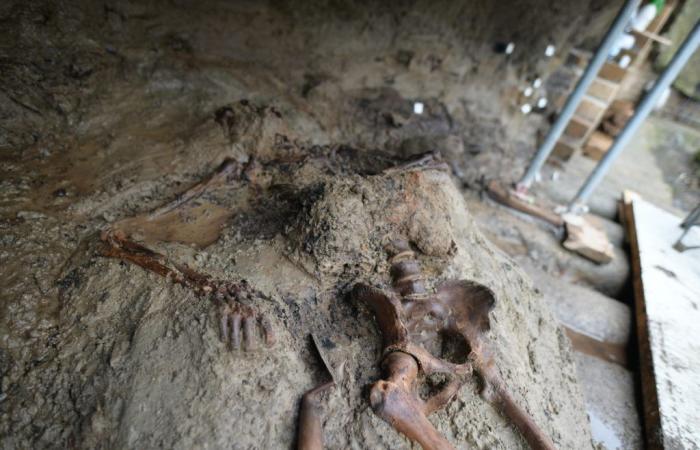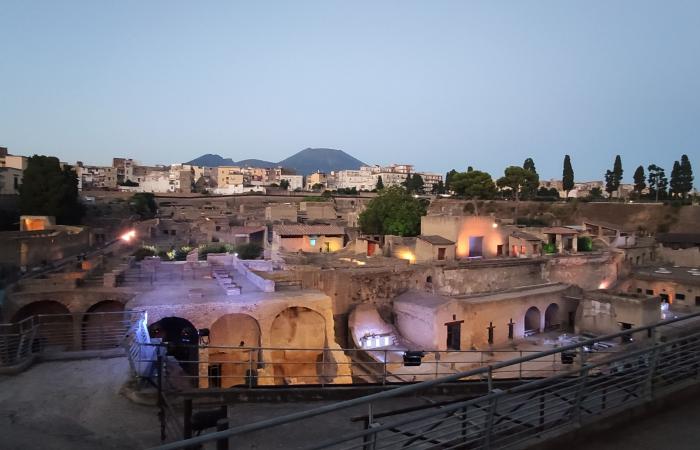The ancient beach of Herculaneum, which recently returned the last fugitive with his belongings – a rough fabric bag with a wooden coin holder, some rings and writing tablets – now reopens to the public.
The first beach inside an archaeological park becomes usable again at the conclusion of a multi-year journey of multidisciplinary research, archaeological excavation, restoration, engineering and architecture activities. The new structure was financed within the coordinated CIS Vesuvio Pompei Napoli managed by the Greater Pompeii Unit.
The last fugitive of Herculaneum | Courtesy Herculaneum Archaeological Park
The ancient Herculaneum, a seaside city, destroyed by the eruption of 79 AD, comes back to life thanks to the final arrangement, on the wave of a design donated by the Packard Humanities Institute as part of the public-private partnership called “Herculaneum Conservation Project” which aims to return an image as close as possible to how it must have appeared before the eruption. The reopening, which now allows visitors to walk across the entire surface, is part of a broad cultural action plan which will enrich the experience of visiting the Park in the short term, while in the medium term it will reunite the main archaeological area with the Villa of the Papyri.
Saved from corrosion and decay, determined by a mixture of natural factors that had transformed the beach into a sort of marsh, the beach now returns to its safety and usability thanks to the creation of a walkable area and the enhancement of the sea front of the Ancient city.
“The ancient beach – said the director of the Archaeological Park Francesco Sirano – is an extraordinary and unique place in the world. If we turn our heads to where the sea once was, we become modern explorers of the immense blanket of volcanic flows that covered the city in a few hours and we cannot help ourselves from sharing almost the sense of total annihilation of our human condition in the face of the evidence of cataclysm of 79 AD We are on the site where archaeological research has highlighted evidence that more than 300 desperate people tried in vain to be saved thanks to a real civil protection operation directed by the admiral and illustrious Roman scholar Pliny the Elder. This project now allows us to combine the extreme historical archaeological interest with topographic and urban planning since it is now possible to appreciate in an area of more than three thousand square meters in a close-up way, and I would say almost as protagonists, the only front sea of a Roman city almost entirely preserved”.
Research begun in the 1980s brought to light over 300 victims of the eruption, who, for the most part, had sought shelter in some warehouses linked to the landing. After some interventions in the 1990s, thanks to the public-private partnership with the Packard Humanities Institute (PHI), the area was included in a strategy aimed at excavations, research, conservation and use according to innovative approaches based on the multidisciplinarity of the interventions planned and with extraordinary results such as the discovery of the polychrome wooden ceiling of the main hall of the house of the Relief of Telefo. In the spring of 2021, work resumed on an ambitious project that aims to redesign and enhance the ancient Herculaneum coastline.
“Interesting data – continues Sirano – emerged from the first works, with the discovery of thousands of wooden finds, mostly belonging to the roofs of buildings torn up and thrown onto the beach by the violence of the pyroclastic flows of 79 AD as well as many fragments of tiles and tiles and some fragments of marble and marble columns”.
Archaeological Park of Herculaneum
But what did the old beach look like? Certainly like an expanse of black volcanic sand from which, in some places, the underlying tuff platform emerged. On the night of the eruption, in addition to the over 300 fugitives, animals such as mules and horses also arrived here. With a temperature of over four hundred degrees centigrade and a speed of 80 kilometers per hour, the first fiery cloud surprised the fugitives in the middle of the night, reaching the city and causing the instant death, due to thermal shock, of all its inhabitants. The arrival of the waves of volcanic mud from Vesuvius did the rest by covering their bodies, sealing them forever in the position they were in at the moment of death.







